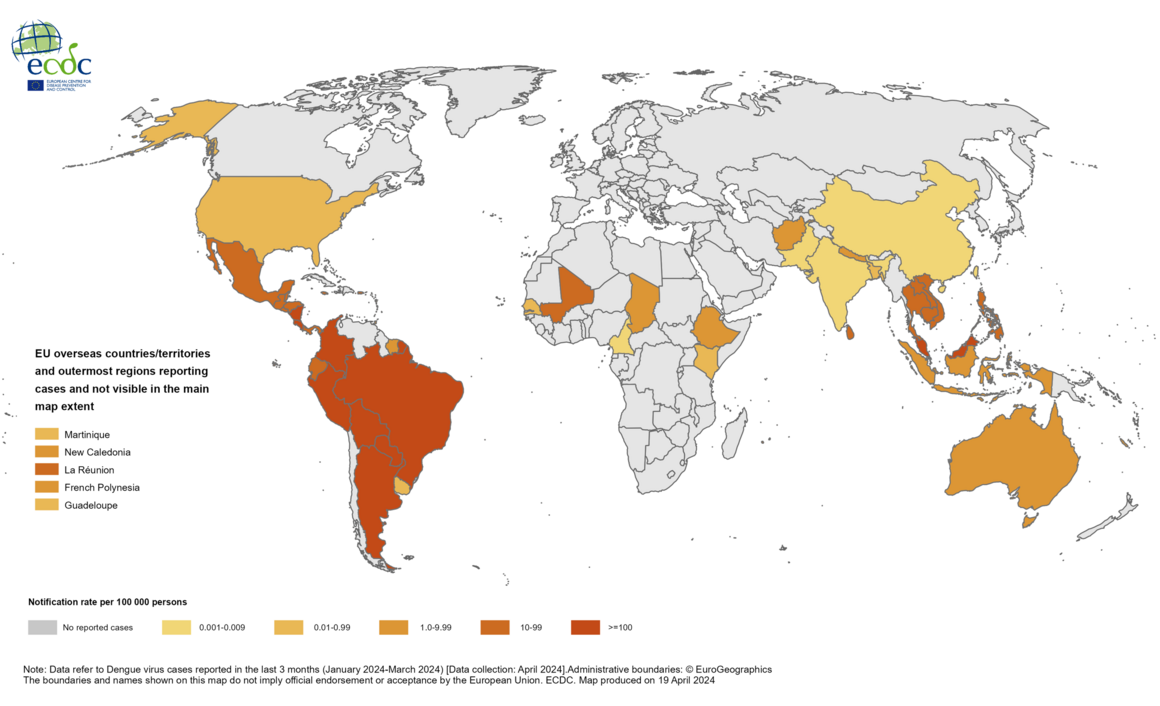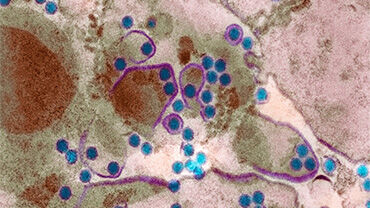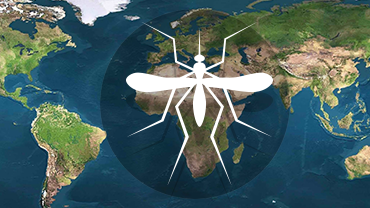Dengue worldwide overview
Situation update, April 2024
Since the beginning of 2024, over five million dengue cases and over 2 000 dengue-related deaths have been reported globally.
No autochthonous/non-travel-associated dengue cases have been reported in Europe in 2024.
Most cases globally have been reported from the WHO PAHO region, with Brazil reporting most cases (over four million: Situation Report No 13 - Dengue Epidemiological Situation in the Region of the Americas - Epidemiological Week 12, 2024 - PAHO/WHO | Pan American Health Organization)
Three-month dengue virus disease case notification rate per 100 000 population, January—March 2024

Detailed overview
Guadeloupe and Martinique continue to face an epidemic classified as in phase 4 and level 1, while dengue circulation in Saint-Barthelemy and Saint-Martin is also ongoing, but at lower levels since mid-March. According to the surveillance report for dengue dated 11 April 2024, there is a stable trend in hospitalisation due to dengue in Guadelpupe and Martinique.
In French Guyana, over 7 000 confirmed dengue cases have been reported since the beginning of 2024, with the weekly number of cases showing a decreasing trend in recent weeks after a peak in January 2024 (French Guyana - 28/03/2024 Epi update).
In La Reunion, according to the report published on 11 April 2024, 495 dengue cases have been reported since the beginning of the year. Given recent increases in cases in La Reunion, the epidemiological situation has been classified as Level 2B which corresponds to 'intensified autochthonous viral circulation with the risk of evolving into an epidemic' (Increase in dengue cases in Reunion Island | Reunion Island Regional Health Agency (sante.fr)). In addition, two cases were reported from Mayotte on 9 April 2024. Dengue circulation has also been reported in the WHO SEARO Region and WPRO Region as well as in Africa in March 2024.
ECDC assessment
Chikungunya virus disease and dengue affect people in most countries of the tropics and sub-tropics. EU/EEA citizens travelling to the affected areas should apply personal protective measures against mosquito bites.
The likelihood of onward transmission of dengue and chikungunya virus in mainland EU/EEA is linked to importation of the virus by viraemic travellers into receptive areas with established and active competent vectors (e.g. Aedes albopictus and Aedes aegypti). Aedes albopictus is established in a large part of Europe. Aedes aegypti is established notably in Cyprus, on the eastern shores of the Black Sea and in the outermost region of Madeira.
The current likelihood of the occurrence of local transmission events of chikungunya and dengue viruses in areas where the vectors are present in mainland EU/EEA is moderate, as the environmental conditions are becoming less favourable for vector activity and virus replication in vectors. In 2023, locally-acquired dengue cases been reported in France, Italy and Spain.
All autochthonous outbreaks of CHIVD and dengue in mainland EU/EEA have so far occurred between June and November.
More information is available on autochthonous transmission of chikungunya and dengue virus in the EU/EEA on ECDC's webpages, and in ECDC's factsheets on dengue and CHIKVD.
N.B: The data presented in this report originates from both official public health authorities and nonofficial sources, such as news media. Data completeness depends on the availability of reports from surveillance systems and their accuracy, which varies between countries. All data should be interpreted with caution and comparisons, particularly across countries, avoided, due to underreporting, variations in surveillance system structure, varying case definitions between countries and over time, and use of syndromic definitions.
Map
Countries/territories reporting dengue cases since April 2023, and as of March 2024
Since the beginning of 2024, five million dengue cases and 2000 dengue-related deaths have been reported from 69 countries/territories.







